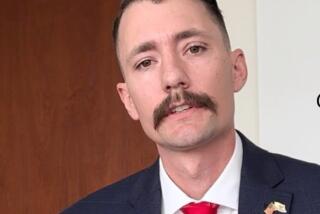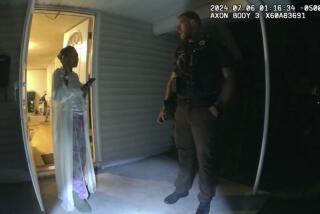Police and community work together to arrest a murder suspect in South L.A.
Venus Mason wasn’t wearing her uniform at the Los Angeles Police Department’s press conference outside the Starbucks on Crenshaw Boulevard. With her bright blouse, matching necklace and auburn-tipped dreadlocks, she looked more like the folks watching from the sidewalk than like her fellow police officers behind the microphones.
That seemed fitting to me, given Det. Mason’s role in the drama that brought us together to mark the arrest of a local man on a murder warrant.
This was no high-profile case, like the Grim Sleeper. The crime took place in Georgia, so nobody here knew the victim. The capture didn’t rely on DNA or generate much outside attention.
But the arrest is important as a textbook example of community policing — of what can happen when officers and residents are on the same page.
It wouldn’t have come about without local residents’ courage and a police officer’s care for them as she did her job.
Community policing is not just about advisory boards and community meetings. It’s about building bridges person by person, by the way you listen to people and treat them. And it takes understanding that respect is a two-way street.
*
The community in this case was a loose-knit group of regulars at the Starbucks in the Crenshaw Plaza — a mix of students, writers, artists, shopping center employees and street hustlers who enjoyed the camaraderie even when they couldn’t afford the coffee.
What they did was turn over one of their compadres — a man they knew as Will Thomas, the shopping plaza’s security guard.
“A nice guy,” said local activist Jasmyne Cannick. Serious, well-mannered and popular with the ladies.
At least until they realized that “Will Thomas” was really Mark Rudolph Reed, an ex-convict wanted for a murder in Georgia three years ago.
A young man in the Starbucks group made the discovery by coincidence. He was scrolling through the Department of Corrections website for information on a friend when up popped the state’s list of “Most Wanted Parolees.” There was Reed’s mug shot — No. 10 — and the warning “Armed and/or Dangerous.”
The young man’s first reaction was disbelief: “I tried to think that maybe it was somebody who just looked like him.” His next thought was, “I’ve got to tell someone.”
He told Cannick, another of the Starbucks regulars. Cannick telephoned Mason, who investigates gangs and homicides, “because I knew Venus was somebody we could trust — and that she would know what to do about it.”
It’s not easy knowing what to do in some parts of Los Angeles, where the criminals are sometimes seen as more powerful — and more trustworthy — than the cops. Reed was such a neighborhood fixture that even local elected officials knew the long-time security guard.
“We asked Venus to find out if this was for real,” Cannick said. “No one wanted to turn him in.... It was hard to imagine that this guy we know — we bring our kids up here and he talks to them — that he’s a cold-blooded murderer.”
What Mason did first was basic police work, confirming a wanted man’s identity.
And what she did next ought to be required too: She listened, responded to a caller’s fears, took careful note of the community’s needs.
The caller wanted anonymity so he would not risk retribution. And everyone in the Starbucks group wanted to be sure the arrest was handled carefully, to protect bystanders from violence.
“We told her, ‘Don’t go to his house, because he has kids.’ ” Cannick recalled. “We wanted to make sure that he’s not shot, that nobody else gets shot. We talked about it and Venus got that. So she was able to go to the watch commander and say, ‘They’re trying to do the right thing, and here are some concerns they have.’ And we were able to work with that.”
Two days later, on July 10, LAPD officers surrounded Reed and took him into custody in the parking lot behind Starbucks, in a sting operation that his former friends watched unfold.
*
Mason grew up in Compton and joined the LAPD 22 years ago “because I wanted the community to see somebody who looks like them,” she told me. “Somebody who gets the slang, the body language … who understands the attitudes.”
She understood the conflict her young caller felt when he wrestled with “snitching” on a friend. She reminded him that “silence is not an honorable attribute.”
That freed him, he told me, “to follow my conscience and do what I knew was the right thing.”
Mason thinks we sometimes make too much of hostilities between police officers and residents in inner-city communities. “What we do is not pretty work, and sometimes community members are uncomfortable with it. But I think they appreciate what we do when they entrust their safety to us.”
At the press conference, Chief Charlie Beck applauded Mason’s sensitivity. “Because of her, the community felt comfortable enough to reach out,” he said, and help capture “a suspect on the run and under our radar since 2007.”
Mason passed the praise along to the folks on the sidewalk, who were watching as the cameras rolled. “Thank you, the community, for believing in the process,” she said.
And she made clear that community policing is a two-way street, lined with choices and responsibilities, that it works best when we act as full partners, not obstacles or enemies.
As she told that young man, worried about turning in his friend: “It’s your community. If you want it to be safe, you have to make the difference.”
More to Read
Sign up for Essential California
The most important California stories and recommendations in your inbox every morning.
You may occasionally receive promotional content from the Los Angeles Times.










